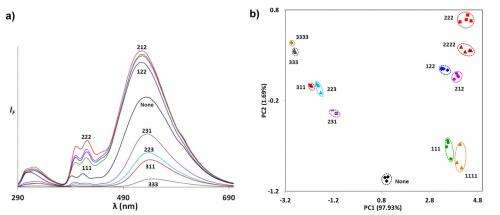October 22, 2013 feature
Chemical passwords could lead to unbreakable molecular lock

(Phys.org) —If you're in the business of cracking codes, it would be pretty difficult to break into a security system that you don't even know is there. That's one of the advantages of molecular keypad locks, whose small sizes make them very difficult to detect. As such, these locks are an example of steganography, since not only is the password hidden, but the very existence of the lock itself is concealed. Another advantage of these tiny locks is that, instead of using electronic signals, they use chemical and optical signals that further complicate their cracking.
Research into molecular keypad locks is still in its early stages, with the first lock being developed in 2007 by Professor Abraham Shanzer and his group at the Weizmann Institute of Science in Rehovot, Israel. So far, creating locks that can authorize more than a single password has been challenging.
Now in a new study published in the Journal of the American Chemical Society, chemists from the Weizmann Institute of Science have demonstrated a molecular keypad lock that can respond to multiple password entries. This ability could enable molecular keypad locks to compete with electronic keypad locks to create extremely secure systems.
The molecular keypad lock that the scientists developed here is based on a combinatorial fluorescent molecular sensor that essentially acts as a molecular "nose" or "tongue" by sensing different chemicals. Unlike most fluorescent molecular sensors that generate discrete optical signals, this sensor can generate unique optical "signatures" for different chemicals, similar to the way the olfactory system operates.
"When an odorant enters our nose, it simultaneously binds and triggers several olfactory receptors," coauthor David Margulies, Senior Scientist at the Weizmann Institute of Science who also helped develop the first molecular keypad lock, told Phys.org. "This generates a unique 'fingerprint' for each odorant, which enables the olfactory system to distinguish between so many smells. In our system, the ability to generate a unique optical fingerprint for each chemical password enables an individual fluorescent molecule to distinguish between so many passwords."

The scientists explained that this ability to generate a unique optical pattern for each password makes this system similar to both an electronic keypad lock and a biometric lock. The first can be opened by entering the right password, while the second is opened by recognizing a unique signature such as a fingerprint. In the case of the molecular keypad lock, both a password and optical fingerprint are required, making this type of lock extremely secure.
With electronic locks, the entry keys are accessible (as they are placed on the keypad) and hence, anyone that has the right password (or stole the correct password) may enter. With biometric locks, on the other hand, each user carries his own "key" (such as his fingerprint) and therefore the keys are, in principle, not accessible. However, in this case, for each user there is only one key, which is known, but not accessible, and there have been events when fingerprints were faked. In the combinatorial molecular keypad lock, not only are the lock or keys not accessible (all are chemicals), but even if one finds them it's not enough. He still needs to know the right password.
In their paper, the researchers used different saccharides (for example, glucose, xylose, fructose, galactose, and maltitol) as the chemicals, which represent the numbers that are typically used in electronic passwords.
Using these saccharides, the molecular keypad lock can respond to passwords containing two, three, and four digits. It can also distinguish between different sequences (e.g., between 112 and 211), which allows for dozens of unique passwords.
Because the system can generate a unique optical fingerprint for each password, it can also be programmed to authorize multiple users. For one user, the system will be programmed to recognize one fluorescence fingerprint (using a pattern-recognition software), whereas for another user, it will be programmed to recognize another pattern. In addition, to make it even more secure, one can also make the system recognize entirely new sets of patterns (thus, passwords) by replacing the chemical inputs. This can be done by screening for new chemical inputs from libraries of saccharides.
The science behind molecular keypad locks can also be applied to other areas, such as biomedical applications.
"Fluorescent molecular sensors are among the most powerful tools used in cell biology due to their small size that enables them to penetrate cells and detect specific ions or biomolecules in their native environment," Margulies said. "Therefore, we believe that beyond their potential to provide an alternative information-protection technology, molecule-sized 'nose/tongues' (our earlier Angew. Chem. Int. Ed. Paper, 2012) or in their more advanced form, keypad locks that can generate unique optical fingerprints for different analytes and their combinations, could be used in analyzing combinations and even sequences of biomolecules within cells, which macroscopic electronic noses or electronic keypad locks cannot access."
More information: Bhimsen Rout, et al. "Authorizing Multiple Chemical Passwords by a Combinatorial Molecular Keypad Lock." Journal of the American Chemical Society. DOI: 10.1021/ja4081748
Bhimsen Rout, et al. "Medication Detection by a Combinatorial Fluorescent Molecular Sensor." Angewandte Chemie. DOI: 10.1002/ange.201206374
Journal information: Journal of the American Chemical Society , Angewandte Chemie International Edition , Angewandte Chemie
© 2013 Phys.org. All rights reserved.

















